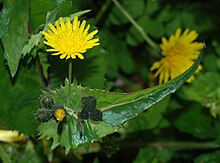Embergeria
| Sow thistles | |
|---|---|
 |
|
|
Sonchus oleraceus (Smooth Sow-Thistle) |
|
| Scientific classification | |
| Kingdom: | Plantae |
| (unranked): | Angiosperms |
| (unranked): | Eudicots |
| (unranked): | Asterids |
| Order: | Asterales |
| Family: | Asteraceae |
| Tribe: | Cichorieae |
| Subtribe: | Hyoseridinae |
| Genus: |
Sonchus L. |
| Type species | |
|
Sonchus oleraceus L. |
|
| Synonyms | |
|
|
Sonchus is a genus of flowering plants in the dandelion tribe within the sunflower family.
Most of the species are annual herbs, a few are perennial, and a few are even woody (subgenus Dendrosonchus, restricted to the Canary Islands).
Annual herbs in the genus are known as sow thistles (less commonly hare thistles or hare lettuces). The genus is named after the Ancient Greek for such plants. All are characterized by soft, somewhat irregularly lobed leaves that clasp the stem and, at least initially, form a basal rosette. The stem contains a milky latex. Flower heads are yellow and range in size from half to one inch in diameter; the florets are all of ray type. Sow thistles are common roadside plants, and while native to Eurasia and tropical Africa, they are found almost worldwide in temperate regions.
Mature sow thistle stems can range from 30 cm to 2 m (1 to 6 feet) tall, depending upon species and growing conditions. Colouration ranges from green to purple in older plants. Sow thistles exude a milky latex when any part of the plant is cut or damaged, and it is from this fact that the plants obtained the common name, "sow thistle", as they were fed to lactating sows in the belief that milk production would increase. Sow thistles are known as "milk thistles" in some regions, although true milk thistles belong to the genus Silybum.
Sow thistles have been used as fodder, particularly for rabbits, hence the other common names of "hare thistle" or "hare lettuce". They are also edible to humans as a leaf vegetable; old leaves and stalks can be bitter but young leaves have a flavour similar to lettuce. Going by the name puha or rareke (raraki) it is frequently eaten in New Zealand as a vegetable, particularly by the native Māori. When cooked the flavour is reminiscent of chard.
...
Wikipedia
